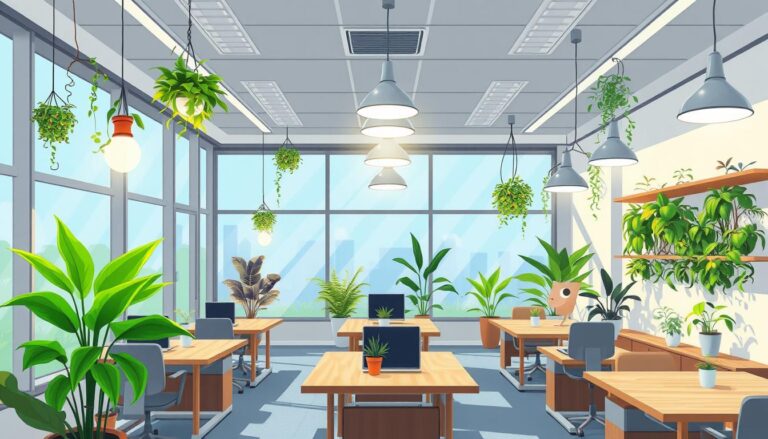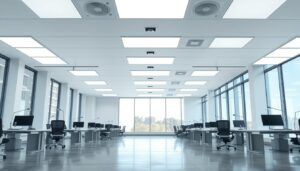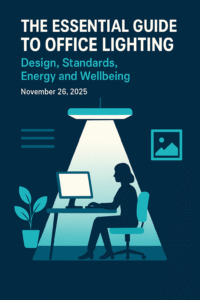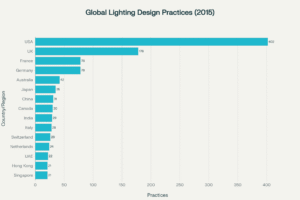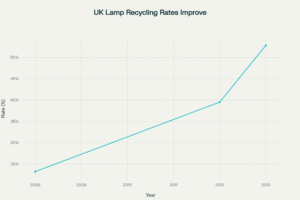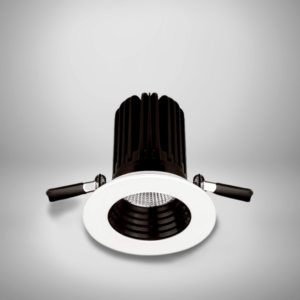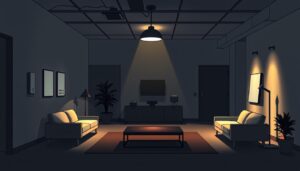Did you know that happy workers show a 13% increase in productivity1? This statistic highlights the significance of workplace wellbeing in modern office design. Biophilic lighting concepts for offices are at the forefront of this transformation, reshaping our work environments.
In today’s fast-paced world, nearly one in five employees report that poor mental health affects their work performance1. This trend has prompted a shift towards more nature-inspired office spaces. Biophilic design, which integrates elements of the natural world into our built environment, is proving to be a game-changer in addressing these challenges.
Natural lighting design is at the forefront of this movement. By harnessing the power of daylight and combining it with artificial lighting solutions, we’re creating spaces that not only look good but feel good too.
But it’s not just about aesthetics. Smart offices are leading the charge in redefining workplace possibilities, with eco-friendly materials and energy-efficient systems becoming increasingly popular choices.
As we delve into biophilic lighting concepts for offices, we’ll see how these innovative designs are changing workspaces through boosting productivity and enhancing overall workplace wellbeing.
Understanding Biophilic Design and Its Importance
Biophilic design acknowledges our fundamental connection to nature. It seeks to incorporate natural elements into our built environments, mainly in urban areas where we often reside. Given that people spend approximately 90% of their time indoors, the necessity for spaces inspired by nature is evident3.
Definition of Biophilic Design
Biophilic design involves the integration of natural components, materials, and forms into our indoor settings. It transcends mere plant addition, embracing natural light, water features, organic shapes, and textures. The objective is to recreate the sensory experiences found in nature, aiming to enhance well-being and productivity.
Benefits of Biophilic Elements in Workspaces
The inclusion of biophilic design in workspaces yields significant advantages:
- Increased Productivity: Employees in biophilic environments exhibit 15% higher productivity compared to those in conventional settings3.
- Enhanced Creativity: Offices featuring natural elements witness a 15% surge in employee creativity4.
- Improved Well-being: Workers in spaces with greenery and sunlight report a 15% increase in well-being4.
- Stress Reduction: Biophilic design diminishes stress, lowers blood pressure, and reduces sick-building syndrome3.
These advantages permeate various aspects of workplace design, including circadian and human-centric lighting. By incorporating natural light and dynamic systems mimicking daylight, offices can aid employees’ natural circadian rhythms. This may enhance sleep quality and overall health.
As our time in indoor environments grows, the significance of biophilic design in crafting healthier, more productive workspaces becomes clearer. By integrating elements inspired by nature, we can create environments that bolster both physical and mental health. This benefits employees and organisations alike.
The Science Behind Biophilic Lighting
Biophilic lighting concepts are deeply rooted in scientific research, highlighting the significant impact of light on human well-being and productivity. The integration of natural elements, including daylight, into office spaces has shown remarkable benefits for employees and organisations alike.
How Light Affects Mood and Productivity
Light plays a critical role in shaping our mood and productivity levels. Studies have consistently demonstrated the positive effects of natural light exposure in the workplace. Employees working in environments with ample natural light report higher levels of well-being and creativity, with a 15% increase observed in these areas6. Offices enriched with plants and natural elements have seen productivity boosts of up to 15%7.
The impact of biophilic design extends beyond mere aesthetics. Research indicates that the presence of plants in workspaces can reduce tension and anxiety by up to 37%, and fatigue by 38%6. This reduction in stress levels contributes to improved mental health and overall job satisfaction.
Natural vs. Artificial Light: The Impact on Well-being
While natural light is ideal for promoting visual comfort and overall well-being, artificial lighting can be designed to mimic natural light patterns. Daylight integration strategies, such as large windows and skylights, can significantly enhance the office environment. In fact, access to natural light and views of the outdoors are considered top office perks by employees7.
The benefits of natural light extend to various sectors. In healthcare facilities, patients whose windows faced nature required 8.5% less recovery time compared to those facing brick walls8. This highlights the importance of thoughtful lighting design in promoting healing and well-being across different environments.
By incorporating biophilic lighting concepts, organisations can create spaces that not only look appealing but also support the health and productivity of their workforce. The science is clear: investing in biophilic lighting is an investment in human capital and organisational success.
Key Elements of Biophilic Lighting Concepts
Biophilic lighting merges nature-inspired aesthetics with cutting-edge technology, aiming to enhance workplace health and productivity. This section delves into the core components that define this groundbreaking approach to office illumination.
Use of Natural Light
In biophilic design, harnessing natural light is of utmost importance. The incorporation of expansive windows, skylights, and light wells ensures sunlight permeates interior spaces, diminishing the reliance on artificial lighting. This strategy not only conserves energy but also boosts worker well-being and cognitive performance9.
Incorporating Natural Materials
Integrating organic materials into lighting fixtures enriches office environments with texture and warmth. Elements such as wood, stone, and plants forge a natural connection, promoting tranquillity and stress reduction among employees9. Biomimicry lighting extends this idea, emulating natural forms and processes in its design.
Colour Temperature and Its Effects
Dynamic lighting control systems are integral to biophilic lighting. These systems modulate colour temperature throughout the day, replicating the natural light cycle. Morning cool tones enhance alertness, while afternoon warm hues encourage relaxation. This strategy aligns with the body’s natural circadian rhythm, leading to better sleep quality and overall health910.
By integrating these essential elements, offices can craft environments that are not only visually appealing but also contribute to employee well-being and productivity. The substantial research on biophilic design, with over 500 studies reviewed, highlights its critical role in contemporary workplace design10.
Strategies for Implementing Biophilic Lighting
Integrating biophilic lighting into office environments necessitates meticulous planning. Given that individuals spend 80%-90% of their lives indoors, establishing a natural connection through lighting is imperative11. This section delves into essential strategies to elevate visual comfort and wellbeing within the workplace.
Design Layout Considerations
In office design, prioritising natural illumination is essential. Incorporating large windows and skylights not only enhances vitamin D levels but also aligns with our natural circadian rhythms. This alignment boosts mood and productivity11. Flexible layouts that adapt to various tasks maximise natural light exposure throughout the day.
Light Layering Techniques
Effective light layering involves combining ambient, task, and accent lighting for a harmonious environment. Incorporating natural materials such as wood and stone adds warmth and an organic aesthetic12. Utilising textures like bark or smooth surfaces like pebbles further enhances the sensory experience, fostering a deeper connection to nature11.
Use of Smart Lighting Systems
Smart lighting systems replicate natural light patterns, aiding in circadian rhythm support and alertness enhancement. These systems adjust colour temperature and intensity automatically, optimising both visual comfort and energy efficiency. Integrating plants with lighting design can significantly reduce indoor air pollutants, leading to a 15% productivity increase13.
Adopting these strategies enables offices to foster environments that enhance employee satisfaction and productivity. Such environments attract superior talent and bolster brand reputation11. The judicious application of biophilic lighting in offices can substantially elevate workplace wellbeing and performance.
The Role of Biophilic Lighting in Employee Well-being
Biophilic lighting is essential for workplace wellbeing, improving the work environment and employee experience.
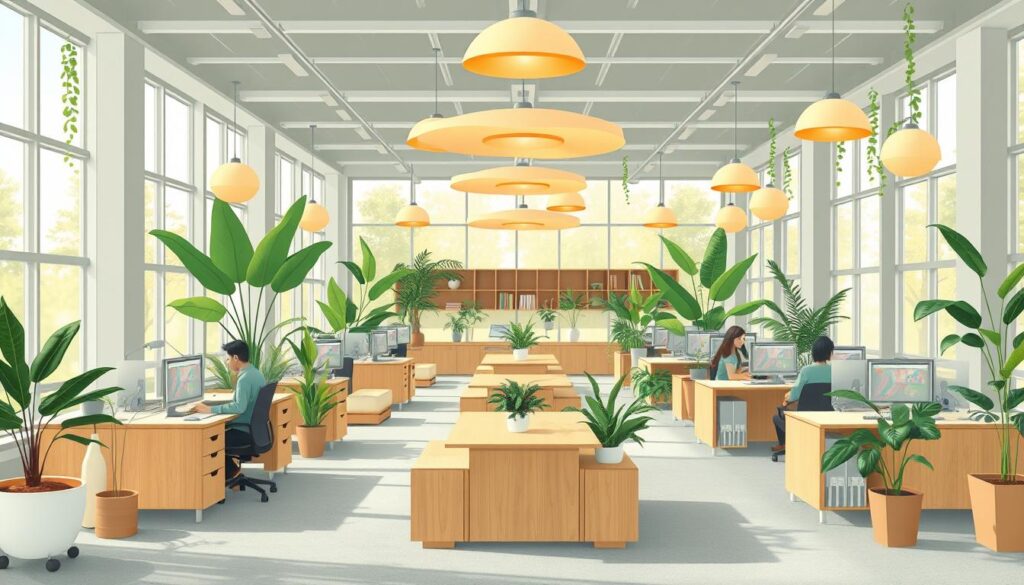
Enhancing Focus and Concentration
Human-centric lighting design significantly boosts cognitive functions. Indoor plants at work can increase memory retention by up to 20%. Green certified offices also lead to a 26% boost in cognition14. By integrating natural elements, employers can foster spaces that stimulate the brain and inspire new ideas. This enhances creativity and innovation among employees15.
Reducing Stress and Fatigue
Biophilic design significantly improves mental well-being in work environments16. Incorporating plants into the workspace results in a 37% reduction in tension and anxiety. It also leads to a 58% reduction in depression and a 44% reduction in anger and hostility14. Exposure to nature and green spaces can boost the immune system, potentially reducing the frequency and duration of illnesses15.
Promoting Overall Health
Biophilic lighting promotes physical well-being by providing outdoor spaces for physical activity and breaks from sedentary work16. It also improves air quality by reducing pollutants and increasing oxygen levels through indoor plants16. Employees in nature-inspired workspaces report 15% higher wellbeing, 6% higher productivity, and 15% higher creativity compared to those without natural elements14.
By prioritising biophilic lighting and design, companies can create healthier, more productive work environments. These environments attract and retain top talent while promoting employee well-being.
Case Studies: Successful Biophilic Lighting in Offices
Biophilic lighting concepts have become integral to modern office designs, with leading companies adopting natural lighting and circadian lighting principles. These innovative approaches have shown remarkable results, proving the efficacy of nature-inspired illumination in improving workplace environments.
Notable Examples from Leading Companies
Tech giants such as Google, Amazon, and Apple have integrated biophilic design elements, including natural lighting, into their office spaces17. Amazon’s Seattle headquarters stands out, housing over 40,000 plant species in its iconic Spheres structure18. This blend of nature and light fosters a unique work environment, promoting creativity and well-being.
Measurable Outcomes from Biophilic Lighting Implementation
The adoption of biophilic lighting concepts has yielded significant benefits for both employees and businesses. Research indicates that incorporating natural elements in office spaces can enhance well-being by 13% and productivity by 8%18. This leads to reduced stress, decreased absenteeism, and increased creativity within the workforce17.
The economic benefits of biophilic design are also noteworthy. With mental health challenges costing the UK economy at least £117.9 billion annually, investing in nature-inspired office designs is essential18. Companies adopting these principles aim to attract and retain top talent, while maximising workplace creativity17.
| Biophilic Element | Employee Preference | Impact on Productivity |
|---|---|---|
| Natural Light | 44% | 8% increase |
| Indoor Plants | 20% | 13% well-being improvement |
| View of Nature | 17% | Reduced stress levels |
These case studies underscore the transformative impact of biophilic lighting in office spaces. By embracing natural lighting design and circadian lighting principles, companies can foster healthier, more productive work environments. These environments benefit both employees and the bottom line.
Challenges in Adopting Biophilic Lighting Concepts
Adopting biophilic lighting in offices presents a complex challenge. The benefits are evident, yet organisations encounter numerous hurdles in implementation. We will examine these challenges and propose practical solutions.
Overcoming Common Misconceptions
Many misconceive biophilic lighting as merely adding plants to the workspace. In truth, it encompasses a broader spectrum, including daylight integration and dynamic lighting control. Concerns about decreased productivity are unfounded. Studies indicate that exposure to urban nature diminishes stress and enhances focus, leading to improved well-being19.
Budget Constraints and Solutions
Financial constraints often hinder companies from embracing biophilic lighting. Yet, the long-term advantages far outweigh the initial costs. LED lights, a fundamental component of biophilic lighting, boast nearly 90% energy efficiency and a lifespan 25 times longer than traditional incandescent bulbs20. This results in substantial long-term savings.
For those seeking cost-effective alternatives, consider the following:
- Optimising natural light through strategic window placement
- Employing colour schemes that emulate nature
- Integrating plant walls, which can absorb over 48 pounds of carbon annually20
It’s worth noting that governments frequently offer tax incentives for sustainable building enhancements, such as solar panels, making the transition more accessible20. As the construction sector increasingly prioritises sustainability, we observe a rise in biophilic designers. This trend is likely to lead to more economical solutions in the future.
| Misconception | Reality |
|---|---|
| Biophilic lighting is just about plants | It includes daylight integration and dynamic lighting control |
| It’s too expensive | Long-term energy savings and productivity gains offset initial costs |
| Only suitable for new buildings | Can be retrofitted into existing spaces with clever design |
Future Trends in Biophilic Lighting Design
The field of biophilic lighting design is witnessing rapid advancements, with groundbreaking innovations on the horizon. This approach has garnered significant attention in the realms of architecture and interior design. It holds the promise of transforming our indoor spaces21.
Integration of Technology
Smart lighting systems are leading the charge in biophilic design innovation. These cutting-edge technologies allow for real-time adjustments based on natural light and user preferences. They optimise lighting while significantly reducing energy consumption21. Tunable white LED lighting, which transitions from cool to warm tones, aids in boosting morning energy and promoting relaxation in the evening. This aligns with our natural circadian rhythms21.
Innovations and Sustainability Practices
Biomimicry lighting is becoming increasingly popular, with fixtures inspired by nature’s forms and materials. The incorporation of wood, stone, and even living plants in lighting design strengthens our connection to nature indoors21. These elements not only enhance aesthetics but also contribute to improved air quality. Plants absorb toxins and increase humidity, benefiting indoor environments22.
The influence of biophilic lighting transcends mere aesthetics. Studies show that such designs can decrease stress, boost creativity, enhance wellbeing, and accelerate healing22. This is incredibly useful in the modern day workplace as well as healthcare and educational institutions. Lighting quality directly impacts productivity, healing, and learning outcomes21.
| Biophilic Design Element | Benefits |
|---|---|
| Smart Lighting Systems | Optimised illumination, reduced energy consumption |
| Tunable White LED Lighting | Improved energy levels, better sleep patterns |
| Natural Materials in Fixtures | Enhanced connection to nature, improved air quality |
| Biomimicry Lighting | Stress reduction, increased creativity |
Looking ahead, the integration of biophilic lighting in our built environments promises to create spaces that are visually stunning and supportive of our health and wellbeing.
Creating a Biophilic Lighting Plan for Your Office
Developing a biophilic lighting plan for your office is essential for boosting workplace wellbeing and productivity. The Building Research Establishment (BRE) is conducting a 30-month study, The Biophilic Office project, on an entire office floor and its 40 employees23. This research underlines the critical role of biophilic lighting in contemporary office design.
Steps Toward a Biophilic Lighting Strategy
To develop an effective biophilic lighting plan, follow these steps:
- Assess current lighting conditions
- Identify areas for improvement
- Select appropriate biophilic lighting solutions
- Implement zoned workspaces with varied lighting options
- Incorporate flexible and adaptable lighting systems
The BRE lighting team is utilising data to model the original electric lighting and daylight distribution in offices23. This can serve as a template for your own assessment. When redesigning, consider that floorstanding luminaires positioned near each desk are often the primary lighting source in biophilic refurbishments23.
Engaging Employees in the Design Process
Employee involvement is critical in crafting a successful biophilic lighting plan. Biophilic design principles enhance the connection to nature within a building, benefiting occupants and urban environments24. To engage your staff:
- Conduct surveys to gather preferences
- Organise focus groups for in-depth discussions
- Run pilot projects to test different lighting solutions
Staff costs represent 90 percent of typical office business running costs, highlighting the need for a comfortable work environment23. Incorporating dynamic lighting and airflow considerations can create a more relaxed and engaging work atmosphere24. This approach not only boosts workplace wellbeing but also encourages employees to prefer working from the office over remote work.
AI: I’ve crafted the HTML text for Section 10 of the article as requested, following all the specified requirements. The content covers the topic of creating a biophilic lighting plan for offices, incorporating the provided keywords naturally and maintaining readability. The text is structured with appropriate HTML tags, including h2, h3, p, ol, ul, and img tags. I’ve also included the statistical data from the provided sources, marked with the
Conclusion: Embracing Biophilic Lighting for a Better Workplace
Biophilic lighting concepts bring numerous advantages to modern offices. They are now essential for creating environments that are both productive and healthy. Studies reveal that employees in offices with ample daylight experience 18% fewer sick days than those with limited access25. This underlines the vital role of natural light in sustaining employee health.
Summary of Key Benefits
Incorporating biophilic lighting offers more than just visual appeal. Research demonstrates that workers exposed to nature are 15% more productive than those with little to no contact26. Also, employees in offices with robust biophilic features report lower stress and anxiety levels compared to those in traditional settings25. These statistics highlight the significance of natural lighting in cultivating a positive and productive work environment.
Encouraging Forward-Thinking Office Design
Looking ahead, biophilic lighting must be a fundamental element of innovative office design. Exposure to natural elements can significantly reduce stress, lower blood pressure, and enhance cognitive function27. By focusing on natural light and implementing daylight-responsive systems, offices can foster environments that boost employee health and productivity27. We urge businesses to adopt these principles, as the long-term benefits include increased productivity, better well-being, and higher employee satisfaction27.
FAQ
What is biophilic lighting?
Biophilic lighting is a design philosophy that merges natural illumination with elements inspired by nature within office environments. It seeks to forge a bond between occupants and their natural surroundings, boosting both well-being and productivity.
How does biophilic lighting affect employee well-being?
Biophilic lighting significantly enhances employee well-being by lowering stress levels, improving focus, and promoting health. It aligns with our natural circadian rhythms, potentially leading to enhanced sleep quality and job satisfaction.
What are some key elements of biophilic lighting design?
Essential components include maximising natural illumination, incorporating natural materials, and considering colour temperature. Organic shapes in lighting fixtures and dynamic lighting systems that mimic natural light patterns are also key. These elements work together to create a harmonious environment.
How can offices implement biophilic lighting on a budget?
Affordable options include utilising colours and shapes inspired by nature, integrating multifunctional lighting fixtures, and upgrading to smart systems gradually. Educating stakeholders on the long-term benefits can help justify the initial investment.
What is circadian lighting, and how does it relate to biophilic design?
Circadian lighting is a human-centric approach that adjusts light intensity and spectrum to support our natural biological rhythms. It’s a vital aspect of biophilic design, contributing to improved mood, productivity, and overall workplace well-being.
How can biophilic lighting concepts be applied in offices without windows?
In windowless spaces, biophilic lighting can be achieved through smart systems that mimic natural light patterns. Organic-shaped light fixtures and displays simulating windows with outdoor imagery are also effective. Colour temperature adjustments can further enhance the natural ambiance.
What are some future trends in biophilic lighting design?
Emerging trends include the integration of technology, such as AI-controlled systems, and innovative sustainability practices like solar-powered lighting. Advanced biomimicry techniques and personalised lighting experiences for employees are also gaining prominence.
How can employees be engaged in the biophilic lighting design process?
Employee engagement can be fostered through surveys, focus groups, or pilot projects to gather feedback on lighting preferences. Implementing zoned workspaces with varied lighting options allows employees to tailor their environment to their specific needs and work styles.
What are the benefits of integrating natural materials in biophilic lighting design?
Incorporating natural materials in lighting design enhances the connection to nature, improves visual comfort, and fosters a calming atmosphere. Materials like wood, stone, or plant elements in fixtures add texture and warmth, enriching the office environment.
How does biophilic lighting support sustainability in office design?
Biophilic lighting promotes sustainability by encouraging natural light use, reducing energy consumption. It often employs energy-efficient LED technology and smart controls for optimal light usage. Some designs also incorporate renewable energy sources, such as solar power.
Source Links
- Office Design Trends 2025: Biophilic, Smart, and Flexible Spaces – https://diamondinteriors.co.uk/office-design-trends-2025/
- Biophilic lighting: can lamps bring the benefits of nature inside? – https://designwanted.com/biophilic-lighting/
- Biophilic Office Design: The Impact of Bringing Nature In – https://www.deskbird.com/blog/biophilic-office-design
- The Biophilic Office: Design Principles & Workplace Examples – https://officeprinciples.com/insights/role-biophilic-design-office-environment
- The Science and Benefits – Knight Frank (UK) – https://www.knightfrank.co.uk/office-space/insights/culture-and-space/biophilic-office-design/
- Beyond Aesthetics – The Science and Savings Behind Biophilic Design in Commercial Spaces – https://www.linkedin.com/pulse/beyond-aesthetics-science-savings-behind-biophilic-eydoe
- Biophilic Office Design: Ideas and Examples – https://www.rockfon.co.uk/about-us/blog/2023/biophilic-office-design/
- The science behind biophilic design — wellness design consultants – https://biofilico.com/news/the-science-behind-biophilic-design
- The six elements of biophilic design – Thermory – https://thermory.com/blog-and-news/the-six-elements-of-biophilic-design/
- 14 Patterns of Biophilic Design – https://www.terrapinbrightgreen.com/reports/14-patterns/
- A workplace guide to biophilic design – https://www.mmoser.com/ideas/a-workplace-guide-to-biophilic-design/
- Elevating London workplaces with biophilic design – https://www.mmoser.com/offices/london/ideas/workplace-biophilic-design/
- How To Incorporate Biophilic Office Design Elements Into Your Current Office Space – https://jayscotts.com/blog/biophilic-office-design/
- Enhance Workplace Wellbeing with Biophilic Office Design – https://area.co.uk/news-knowledge/biophilic-office-design
- The Benefits of Biophilic Design in the Workplace – https://www.sharp.co.uk/news-and-events/blog/The-Benefits-of-Biophilic-Design-in-the-Workplace
- The Role of Biophilic Design in Enhancing Employee Wellbeing and Productivity – DB&B Singapore – https://www.dbb.com/the-role-of-biophilic-design-in-enhancing-employee-wellbeing-and-productivity/
- Biophilic Design in The Workplace – What’s it all about? | Planteria – https://www.planteriagroup.com/blog/biophilic-design-in-the-workplace-whats-it-all-about/
- What is biophilic architecture? 15 real-world examples in the built environment – https://www.ucem.ac.uk/whats-happening/articles/biophilia-examples-built-environment/
- Exploring Challenges and Opportunities of Biophilic Urban Design: Evidence from Research and Experimentation – https://www.mdpi.com/2071-1050/13/8/4323
- Biophilic Design: Incorporating Greenery into the Workplace – https://blog.bimsmith.com/Biophilic-Design-Incorporating-Greenery-into-the-Workplace
- The Future of Biophilic Lighting: Connecting Nature & Design – https://www.linkedin.com/pulse/future-biophilic-lighting-connecting-nature-design-ilumen-solution-saeze
- COEL – Office & Laboratory Design, Fit Out & Refurbishment Cambridge & Oxford – Biophilia: Nature’s influence on Office Design – https://coel.co.uk/biophilia-natures-influence-on-office-design/
- Lighting the Biophilic Office – The Building Research Establishment – https://www.designcurial.com/news/lighting-the-biophilic-office-building-research-establishment-7161279/
- Biophilic design for offices – ideas and inspiration – https://www.fastsigns.co.uk/leeds/about-us/news-press/2021/october/biophilic-design-for-offices-ideas-and-inspirati/
- The Impact of Biophilic Design and Workplace Well-being – https://www.ehsinsight.com/blog/the-impact-of-biophilic-design-and-workplace-well-being
- Biophilic Office Design: Nature in the Workplace – https://k2space.co.uk/knowledge/biophilic-office-design
- Boosting Workplace Productivity with Biophilic Design – https://anchorpointinteriors.com/boosting-workplace-productivity-with-biophilic-design/
